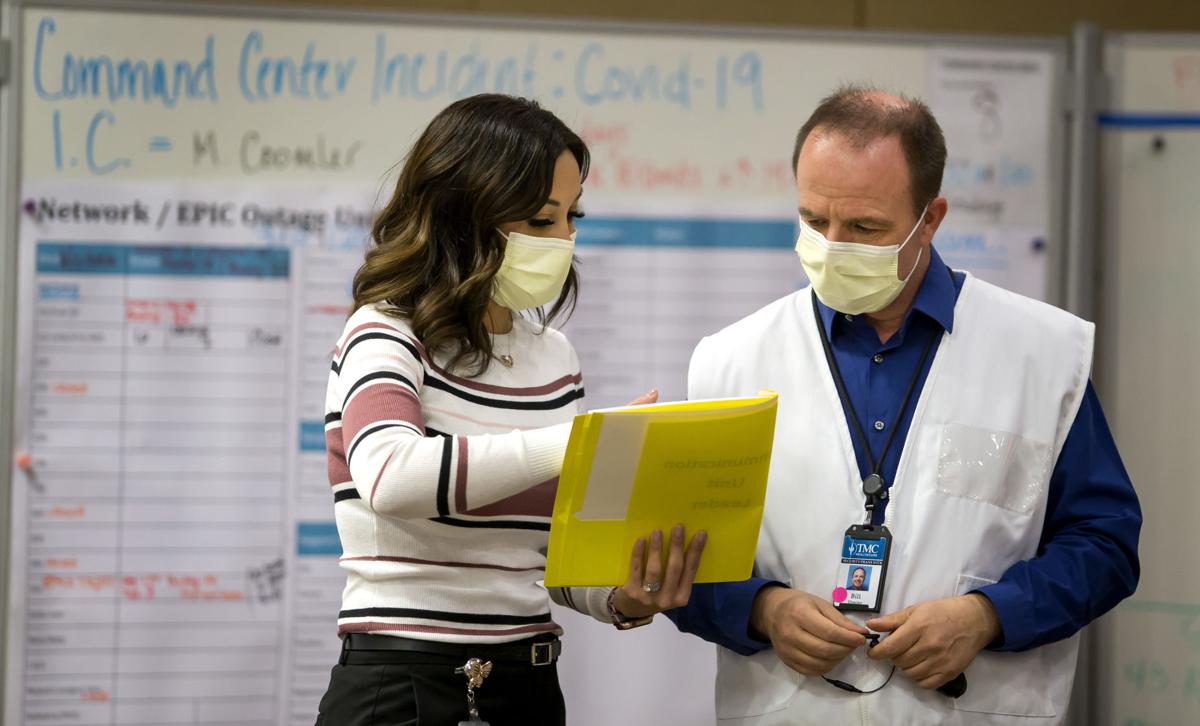The coronavirus pandemic is intensifying in Arizona, mounting evidence shows, with hospitals seeing sharp increases in patients and emergency-room visits.
Last week marked the largest week-to-week increase of coronavirus cases in both Arizona and Pima County since the pandemic began, and Banner Health is reporting its ICUs are at full capacity in Maricopa County and rapidly approaching full capacity in Tucson.
New, confirmed cases in Arizona totaled 4,500 from May 24 to May 30, according to the Arizona Department of Health Services, as of Saturday morning. That’s nearly a 50% increase from the week before.
In Pima County, cases totaled 481 over the same period, marking an 85% increase from the previous week.
The county Health Department is watching closely to see if these cases will turn into hospitalizations, visits to intensive care units and ultimately deaths, said Dr. Francisco Garcia, the county’s chief medical officer.
“The jury is still out,” he said. “This is top of mind for all the hospitals and certainly for us here.”
But Dr. Marjorie Bessel, Banner Health’s chief clinical officer, said on Friday that COVID-19 hospitalizations are rapidly increasing and that, if these trends continue, Banner will soon need to start surge planning and increase bed capacity.
Most concerning, she said, is the steep incline of COVID-19 patients on ventilators. As of Thursday, Banner had 116 COVID-19 patients on ventilators statewide.
Across all Arizona hospitals, 34% of ventilators were in use on the same day, according to the Arizona Department of Health Services. In late March, by comparison, 20% to 23% of ventilators were in use.
“A few weeks ago, we had a nice drop in the number of critically ill patients, but over the last couple of weeks there’s been a slow uptick,” said Dr. Christian Bime, a pulmonary disease and critical-care doctor at Banner-University Medical Center, 1625 N. Campbell Ave.
Bime said what’s happening at Banner is the same as what’s being reported by the Arizona Department of Health Services.
The changing trends are worrisome, he said.
The health department’s data show cases increasing at a faster rate than diagnostic testing. The week ending on May 30 saw tests increase by about 14% statewide, compared to the 50% increase in cases. The same week saw tests increase by about 34% in Pima County, compared to the 85% increase in cases.
“The increased testing alone doesn’t seem to be a plausible explanation of why so many more cases were identified,” said Dr. Joe Gerald, an associate professor with the University of Arizona’s Zuckerman College of Public Health.
The rate of positive test results is also trending upward. As of Friday, it had doubled between May 10 and May 31.
At the same time, the number of tests have been increasing, Gerald said. “Finding a positive case is just now easier to do.”
While there’s no “right or wrong” positivity rate, ideally it would decrease over time, he said.
The percent of positive tests is a relative measure that can also be compared with testing in other locations, he said. “If you have a much higher positivity rate than other locations, then the suggestion is you’re not testing enough.”
The increase in testing and percent of positive tests is “concerning” and “should give us all pause,” Garcia said.
There’s also a clear, upward trend in the number of inpatient coronavirus patients in hospitals statewide, up from 818 on May 25 to 1,234 on June 4.
The data suggest that the number of these patients is increasing at a faster rate over the past seven to 10 days than was seen prior to May 25, Gerald said, adding that the number of coronavirus patients in emergency rooms across the state is also increasing.
It’s “a little bit interesting,” however, that the recent number of coronavirus patients in intensive care units has not mirrored this upward trend in inpatient patients, he said. “Normally, we would expect a those to be highly correlated.”
Even so, Gerald said, “I’m becoming more convinced that conditions are worsening.”
Multiple things are making viral transmission more likely, he said. The expiration of Gov. Doug Ducey’s stay-at-home on May 16 is among several factors, like general quarantine fatigue, that have pushed more people to interact with each other.
In Pima County, the number of coronavirus cases has increased most among younger age groups who presumably have less severe cases, Garcia said. But he said he still worries about every coronavirus case.
Next week he will pay close attention to how many people are hospitalized and who they are, he said. “That’s when we’re going to know how bad this peak is.”
Right now coronavirus deaths represent the racial and ethnic breakdown of the community, he said. Most deaths have been older white patients.
But new cases are increasing among Latinos.
“So will that change if all these other young people who are browner end up being in hospitals? Absolutely,” he said. “That’s where I’m spending time stressing.”
Bime cautions people to remember that the virus is unpredictable and can be hard on otherwise healthy individuals, not just those at high risk due to preexisting medical conditions or age.
“We are hoping that people will continue to be responsible,” he said. “We are hoping that people will continue to avoid gatherings larger than 10, that they will stay home as much as possible and that they will wear a mask when they are in public near other people.”
“We were able to flatten the curve and to get to a point where we were able to begin to open up our community, but we must do that responsibly,” he said.
Banner is still treating patients who were initially hospitalized in April and early May, he said, and there are also more patients hospitalized for other medical needs and previously postponed surgeries.
“COVID-19 is still here with us. It hasn’t gone away, and it won’t go away for a long time, and we must learn to live with it in a responsible way until we have a vaccine or a cure.”
As of Thursday, regular inpatient hospital beds were at 83% capacity statewide, up from 64% capacity toward the end of March, due to both COVID-19 and patients receiving medical care and surgeries they’d previously postponed.
While cases have increased countywide, hospitals across Pima County have reported a variety of trends among their own patients.
Northwest Medical Center and Oro Valley Hospital have not seen a big decline or spike in COVID-19 inpatients, said Veronica Apodaca, director of marketing for Northwest Medical Center, 6200 N. La Cholla Blvd., and Oro Valley Hospital, 1551 E. Tangerine Road.
But the numbers fluctuate daily, she said. “Our census has remained relatively stable over the past few weeks. Each patient is different, and we have treated patients who have had relatively short stays that have not required ICU care and have also had patients who are more seriously ill and have been here for a month or longer before discharging.”
Tucson Medical Center, 5301 E. Grant Road, has seen an increase in cases.
“Though we have seen an uptick in cases these past couple of weeks, patients seem to be less sick than what we saw in the beginning,” said Angela Pittenger, spokeswoman for TMC. “We think this is because people are more aware of symptoms and are seeking care sooner.”
Pittenger said the severity of coronavirus cases varies at TMC.
“Some present at the emergency department and go home right away, whereas others might be in the hospital for 30 days or longer,” she said. “One commonality is those with the most severe cases tend to be over age 65 or have preexisting conditions such as diabetes and heart disease.”
Carondelet hospitals are seeing COVID patient admissions “consistent with the trends being reported by public health,” said Angela Martinez, communications specialist with Carondelet Health Network, which includes St. Joseph’s Hospital, 350 N. Wilmot Road, and St. Mary’s Hospital, 1601 W. St. Mary’s Road.
“It’s a good reminder to all of us that we cannot let our guard down and must remain vigilant about our safety precautions and social distancing.”
"We're tough as saguaros," editorial cartoonist David Fitzsimmons says. He says he saw a video made for the people of Detroit and became inspired to do his own take for Tucson.
Photos for May 29: Tucson gets by during Coronavirus Pandemic
Tucson gets by during coronavirus pandemic
Updated
The iconic Casa Molina bull and matador statue both sport masks on the first full week of the loosening of COVID19 restrictions, May 23, 2020, Tucson, Ariz. The bull previously had a mask on the testicles.
Tucson gets by during coronavirus pandemic
Updated
Michelle Leon Cordova, right, mother, and her son Sahuarita High School senior Lino Cordova, whom is fighting cancer, wave at staff members from Diamonds Children Center, friends and the Marana Police Department during a car parade, celebrating Lino's graduation, outside of his home on May 13, 2020 in Sahuarita, Ariz. Cordova stood on the sidewalk while the team from Diamond Children Center, friends and the Marana police department gave Cordova a graduation gar parade. Cordova was given a gift basket with his favorite snacks, gift cards as well as other items he enjoys. The car parade, also, celebrated another graduating senior fighting cancer from Empire High School, Noah Nieto. Nieto, also, received a gift basket with snacks, gift cards and other items Lino enjoys.
Tucson gets by during coronavirus pandemic
Updated
Michelle Leon Cordova, right, mother, brings celebration balloons to a car after staff members from Diamonds Children Center, friends and the Marana Police Department celebrate Sahuarita High School senior Lino Cordova, whom is fighting cancer, graduation with a car parade outside of his home on May 13, 2020 in Sahuarita, Ariz. Cordova stood on the sidewalk while the team from Diamond Children Center, friends and the Marana police department gave Cordova a graduation gar parade. Cordova was given a gift basket with his favorite snacks, gift cards as well as other items he enjoys. The car parade, also, celebrated another graduating senior fighting cancer from Empire High School, Noah Nieto. Nieto, also, received a gift basket with snacks, gift cards and other items Lino enjoys.
Tucson gets by during coronavirus pandemic
Updated
Personnel from Tucson Medical Center line the heliport to watch A-10's from Davis-Monthan Air Force Base's 355th Wing and F-16's from the Arizona Air National Guard's 162nd Wing make a pass over the facility, one leg of an area wide community flyover, May 14, 2020, Tucson, Ariz.
Tucson gets by during coronavirus pandemic
Updated
Nancy Celix-Campos, right, a respitory therapist at Tucson Medical Center, watches the military flyover with her daughters, Giana, 12, and Jazmyn, 8, from Sentinel Peak on May 14, 2020. Two F-16 Fighting Falcons from Arizona Air National GuardÕs 162nd Wing and two A-10 Thunderbolt II's from the 355th Wing, assigned to Davis-Monthan Air Force Base, fly over Tucson area hospitals to honor healthcare personnel and first responders as they are some of the frontline workers dealing with the coronavirus disease (COVID-19) head on. "It's been an exhausting two to three months," says Campos, "it's pretty cool, I like how they're going by each hospital."
Tucson gets by during coronavirus pandemic
Updated
Two F-16 Fighting Falcons from Arizona Air National Guard’s 162nd Wing and two A-10 Thunderbolt II's from the 355th Wing, assigned to Davis-Monthan Air Force Base, fly over Northwest Medical Center north of Tucson on May 14, 2020.
Tucson gets by during coronavirus pandemic
Updated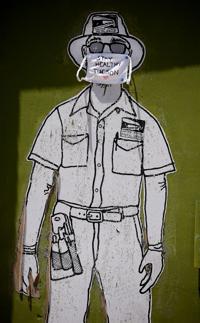
A letter carrier portrait on the Ok Market building, located in the Armory Park neighborhood, is adorned with a face mask on May 18, 2020.
Tucson gets by during coronavirus pandemic
Updated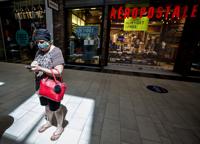
Rosemary Garcia waits for a family member outside of a store at Park Place Mall, 5870 E. Broadway Blvd., in Tucson, Ariz. on May 19, 2020. Malls reopened today under CDC guidelines and Gov. Ducey's new rules for businesses due to the Coronavirus pandemic. Park Place Mall has signs throughout the mall reminding customers to keep a six feet distance as well as hand sanitizer stations near each entrance. About half of the tables in the food court have been removed to allow for social distances as well as less than half of the stores have opened with new guidelines. Of the stores open, only 10 customers are allowed to shop in each store at a time.
Tucson gets by during coronavirus pandemic
Updated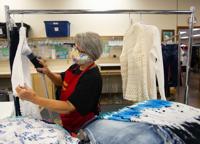
Pat Schlote steams clothing before it is put on the sales floor at the Golden Goose Thrift Shop in Catalina, Ariz., on May 21, 2020.
Tucson gets by during coronavirus pandemic
Updated
Ada Contreras, teaching assistant, looks through containers while reorganizing toys at Herencia Guadalupana Lab School, 6740 S. in Tucson, Ariz. on May 21, 2020. As Child care centers begin to re-open when they are ready, Herencia Guadalupana Lab School is reorganizing and cleaning everything in the facility before re-opening on June 2. To allow for social distancing and decrease the amount of items children touch, Herencia Guadalupana Lab School has sheds where items will go as well as placing items in containers organized by category.
Tucson gets by during coronavirus pandemic
Updated
Jen Martinez, right, softball coach, teaches Skylar Reilly about hitting during a session at Centerfield Baseball Academy, 5120 S. Julian Dr., in Tucson, Ariz. on May 21, 2020. After re-opening on Monday, Centerfield Baseball Academy has implemented new policies in response to the Coronavirus Pandemic such as wearing masks, cleaning, signage, hand sanitizer and limiting the amount of people inside the facility.
Tucson gets by during coronavirus pandemic
Updated
Karl Bosma, left, and George Cantua, with facilities and maintenance, lay down stickers to mark six-foot separation distance around one of the baggage carousels, part of the efforts at Tucson International Airport to work within the restrictions of COVID19, May 22, 2020, Tucson, Ariz.
Tucson gets by during coronavirus pandemic
Updated
A lone passenger waits for a flight near one of the shuttered restaurants in the B Gates before Memorial Day at Tucson International Airport on May 22, 2020.
Tucson gets by during coronavirus pandemic
Updated
Drew Cooper on the stage in the St. Philip's Plaza courtyard, May 22, 2020, Tucson, Ariz., where live music is back on the schedule.
Tucson gets by during coronavirus pandemic
Updated
Many people visit Tumamoc Hill during the first day of Tumamoc's re-opening in Tucson, Ariz. on May 25, 2020. After being closed due to the Coronavirus pandemic, Tumamoc Hill re-opened with some modifications. There are hand sanitizer stations throughout the hike to the top as well as arrows, spaced 10-ft apart, lined up and down the hill. Some runners, hikers and walkers are also wearing masks during their hike. "The steps we are taking aim to provide our community with needed exercise, connection to our beautiful desert and a sense of comfort in such a trying time, while balancing the fact that gathering as a community endangers each of us and our loved ones. This is an unprecedented challenge that we are taking extremely seriously," said Benjamin T. Wilder, director of Tumamoc Hill. Visitors are also asked to limit their group to three people and to not touch the gate at the top of the hill- a tradition for some who make it to the top. "This is a time when we need to establish new traditions and adapt in a creative manner that embraces empathy, unity, care and patience," Wilder said.
Tucson gets by during coronavirus pandemic
Updated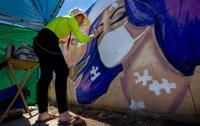
Pen Macias, artist, works on part 2 of a mural for a client on E. Broadway Rd., between S. Columbus Blvd. and S. Alvernon Way, in Tucson, Ariz. on May 25, 2020. Macias, known as The Desert Pen, has been working on her clients mural for the past three months. "It's the one thing I love, I have a passion for and the only thing I could be happy doing," said Macias. The mural represents her client, a single mother of four who works in the health care field. One half of the mural is dedicated to the connection between mothers and their children. The other half is dedicated to the connection between nurses and patients. The client wanted some positivity in the mural to show how nurses give a piece of themselves to their patients hence the puzzle pieces in the nurse and the patients, said Macias.
Tucson gets by during coronavirus pandemic
Updated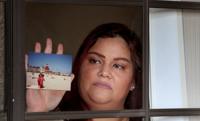
Christina Cortinas, posing at her home, May 28, 2020, Tucson, Ariz., with a photo of her and her mother, Catherine Rodriguez, in San Diego, 1991. Rodriguez is currently in assisted living and fighting COVID19. Cortinas hasn't seen her mother in months, the longest such span in her life.
Tucson gets by during coronavirus pandemic
Updated
Ruben Lopez looks through handouts while attending a Eviction Resource Fair with his family outside the Pima County Justice Court.



